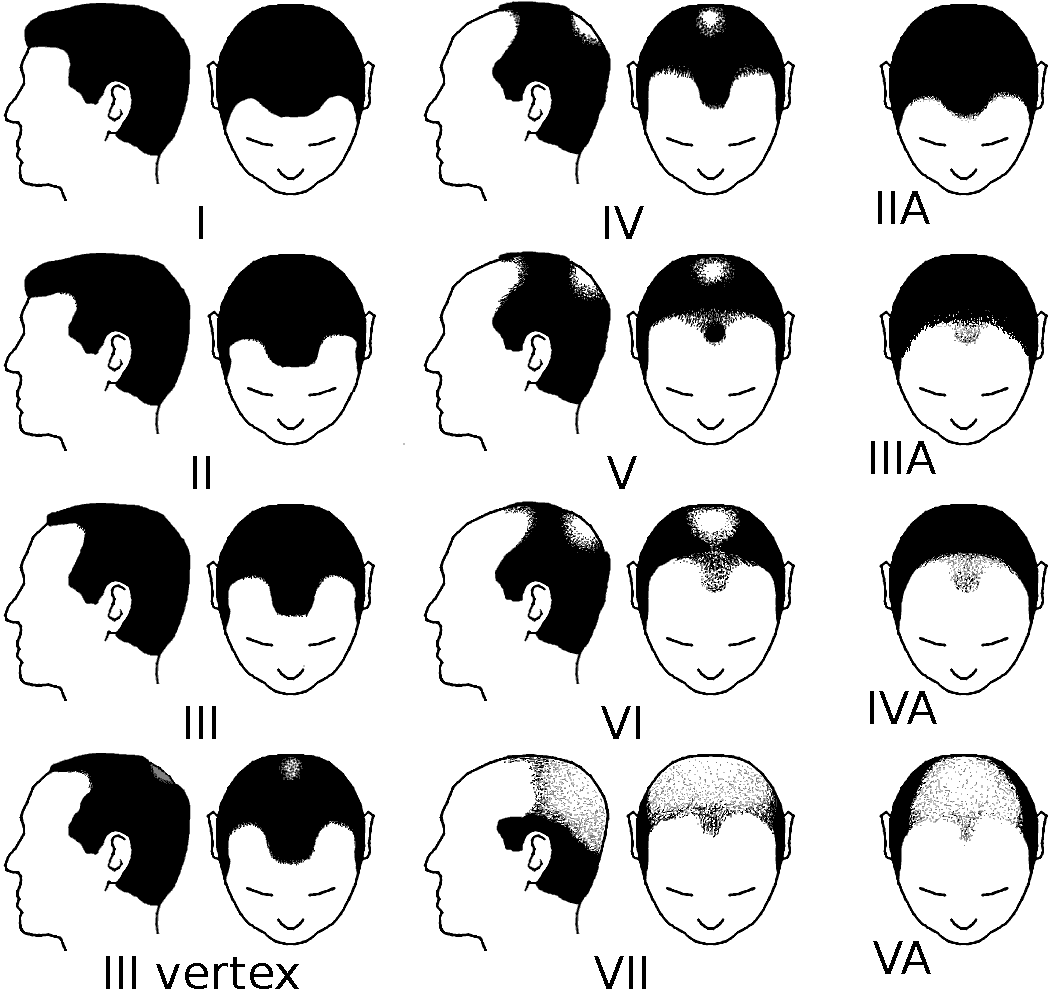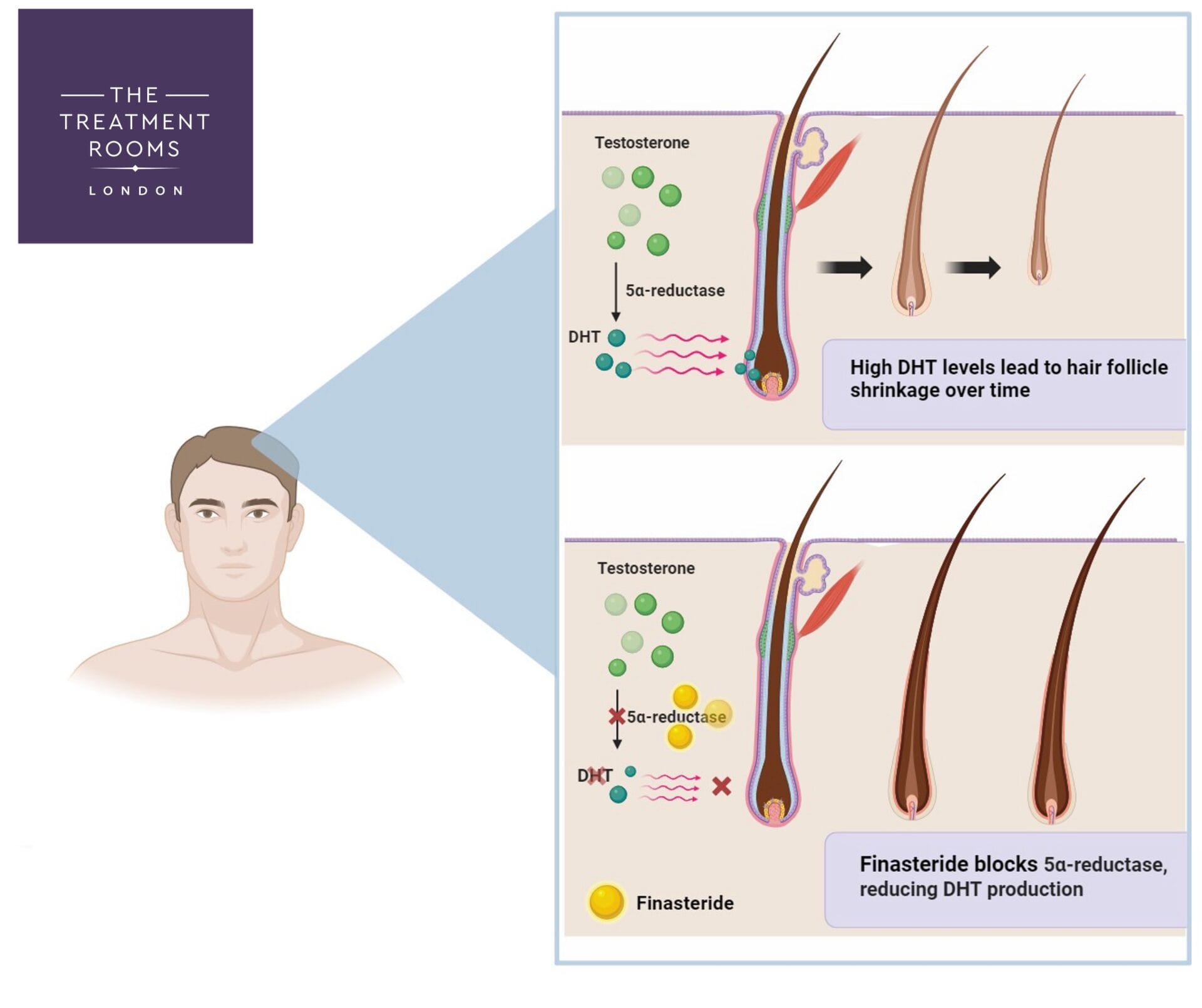One of the main effective medications in treating hair loss is Finasteride, which is often prescribed to men who are experiencing hair loss in their hairline, crown or temples. The medication works by reducing the main hormone, dihydrotestosterone “DHT”, which causes hair loss. In this article, you will read more about how Finasteride works and the risks associated with it.
In the video below you can hear from one of our patients and their experience with Finasteride.
How does Finasteride work?
Dihydrotestosterone (DHT) is a hormone that is derived from testosterone, which is produced in the testes and adrenal glands. DHT is responsible for the development of male sexual characteristics, such as facial hair, deepening of the voice and muscle growth. However, in people with androgenic alopecia (male pattern baldness or female pattern baldness), too much DHT causes your hair follicles to shrink and eventually stop producing hair. The process of DHT causing hair loss can be categorised into a 7 stage scale which is called the Norwood scale. This is shown below:

Finasteride works by blocking the conversion of testosterone to DHT by inhibiting the enzyme 5-alpha reductase. By reducing the DHT levels, Finasteride can help to reverse the process of hair loss and promote hair regrowth in men. The process is summarised in the diagram below:

Can Finasteride regrow hair?
Clinical studies have shown that Finasteride can be an effective treatment for male pattern baldness. In a randomised placebo-controlled study of 1,553 men with androgenic alopecia, Finasteride was found to significantly increase hair regrowth compared to placebo.
Success rates for hair regrowth with Finasteride do vary depending on the severity of your hair loss. In general, Finasteride is most effective for mild to moderate hair loss that has resulted in hairline recession and crown thinning.
Different factors can impact the effectiveness of Finasteride, such as:
- Age
- The severity of your hair loss
- The duration of your hair loss experience
Finasteride is most effective when used consistently for at least 6-12 months, and results may take up to a year to become apparent. It is important to note that Finasteride is not effective for hair loss caused by chemotherapy, autoimmune disorders like alopecia areata or nutritional deficiencies.
When can you start taking Finasteride?
You ought to avoid taking Finasteride until you have developed all male sexual characteristics. This includes the development of facial, beard and pubic hair. This is because the hormone DHT is important in the development of these features.
Once you have matured in your male sexual characteristics, you can start Finasteride under the proper guidance and counselling by your Doctor. Finasteride often works to help patients in the mild to moderate stages of their hair loss to prevent it getting worse and to regrow hair that has thinned. Patients who are characterised as norwood 2, norwood 3 and norwood 4 would benefit well from taking Finasteride to prevent their hair loss getting worse.
Patients with Norwood 5 and 6 patterns of hair loss will also benefit from Finasteride depending on their goals for treatment. This is best discussed with their Doctor or hair transplant surgeon.
Does Finasteride work in Norwood 7 patients?
If you have lost all your hair on your scalp, you will be categorised as Norwood 7. In such patients Finasteride might not work to regrow your hair but you may be advised to take the medication to preserve the hair on the back and sides to help facilitate surgery.
What are the potential side effects of Finasteride?
Like any medication, Finasteride can cause side effects in some people. The most commonly reported side effect of Finasteride is sexual dysfunction. This includes decreased libido, erectile dysfunction and decreased ejaculate volume.
These side effects can occur in more than 1 in 100 people, but they usually resolve after stopping the medication. In some patients these side effects can linger longer causing a lesser understood condition called post finasteride syndrome. It is difficult to understand whether this syndrome is caused by Finasteride but it is important patients are aware of it before starting.
Other potential side effects of Finasteride can include breast tenderness, breast enlargement and rash. These side effects are less common and usually resolve after stopping the medication. Finasteride can affect your semen quality, so if you are actively trying to conceive, speak with your doctor beforehand.
Rare side effects of Finasteride
In rare cases, Finasteride can cause severe allergic reactions, such as swelling of the face, lips, tongue, or throat and difficulty breathing. If you experience any of these symptoms after taking Finasteride, seek medical attention immediately.
Before starting treatment with Finasteride, it is important to discuss any medical conditions or medications with a healthcare professional.
Finasteride use in women
Finasteride is not recommended for use in women, as it can cause birth defects if taken during pregnancy. Women who are pregnant or may become pregnant should avoid handling crushed or broken tablets of Finasteride, as the medication can be absorbed through the skin and cause harm to a developing foetus. You can read more about this in our dedicated article: Finasteride use in women.
Before starting treatment with Finasteride, it is important to discuss any medical conditions or medications with a healthcare professional.
What should I know before taking Finasteride?
Before taking Finasteride, it is important to talk to your doctor about the risks and benefits of the medication. Finasteride is typically taken in tablet form, once a day, with or without food.
The recommended dose for male pattern baldness is 1mg per day, although the dosage may vary depending on individual factors. Never take any more than your recommended dosage.
To minimise the risk of side effects, taking the medication at the same time each day, avoiding alcohol and recreational drugs, and maintaining a healthy lifestyle with regular exercise and a balanced diet could possibly help reduce them.
Long-term use of Finasteride may be necessary to maintain hair regrowth, but it is important to monitor any potential side effects or changes you experience while taking it. Sometimes, your dosage may need to be adjusted, or you might even have to switch to a different treatment if it is not effective or causes too many side effects.
How do you know if Finasteride is working?
Regular follow-up appointments with your doctor are important to monitor the effectiveness of Finasteride and to address any concerns or side effects. We commonly advise patients to take photos in the same lighting from the front, sides and the top to monitor the effectiveness of Finasteride.
If you feel Finasteride is not working, please don’t increase your dosage or stop taking Finasteride without consulting your doctor first.
When to have a hair transplant if you are on Finasteride
If you have been taking Finasteride you may have stabilised your hair loss. You may now want to restore your hairline, temples and crown with a hair transplant. It is important to carefully consider your options and how best to manage your donor area. Choose your Surgeon and clinic carefully who will consider your long term hair goals. At The Treatment Rooms London all patients are seen by their dedicated hair transplant surgeon, Dr Roshan Vara, Dr Dilan Fernando or Dr Puroshini Pather who are able to guide them through the decisions required.
Finasteride FAQs
We’ve covered some Frequently asked questions about Finasteride below.
How long does it take for Finasteride to work for hair loss?
When you take Finasteride, it can take several months to a full year before you see any visible results and hair regrowth. This is because your hair itself only grows around half an inch per month, making it hard to see results in a short space of time, even with Finasteride to help.
Finasteride is not a cure for hair loss, and stopping the medication can result in a return to previous levels of hair loss over time. You can read about this topic in our dedicated article: how long does it take finasteride to work?
Can Finasteride regrow hairline?
Finasteride is said to be most effective at regrowing hair on your crown and less effective at regrowing your hairline. However, that doesn’t mean that it can’t boost hair growth around your hairline; it just might not work as well or it may take longer to see results.
Is Finasteride safe for long-term use?
Finasteride is considered safe for long-term use. But regular monitoring for side effects and effectiveness is recommended, so you will need to speak with your doctor regularly to check that it’s still working well for your body. Your doctor will advise you on the right monitoring schedule for your needs.
Additionally, if you experience any new or concerning side effects while taking Finasteride, you must notify your doctor immediately. Regular communication with your doctor is crucial to ensuring the continued safety and effectiveness of using Finasteride as a hair loss treatment.
Do you have to take Finasteride after getting a hair transplant?
If you have undergone a hair transplant procedure, your doctor or surgeon may recommend that you continue taking Finasteride after the surgery to support hair growth and prevent further hair loss. This is because the hair transplant procedure doesn’t prevent the progression of hair loss in areas of the scalp not treated by the procedure.
Continuing to take Finasteride may help prevent the development of male pattern baldness in areas of the scalp that were not transplanted too.
It is essential to discuss the potential benefits and risks of continuing Finasteride use after a hair transplant with your doctor or surgeon. They can provide you with personalised advice on whether the medication is appropriate for your specific needs and help you decide the best course of action for maintaining your hair growth and preventing future hair loss.
Below you can listen to Dr Fernando talk about whether you need to consider Finasteride if you are having a hair transplant.
Can women use Finasteride for hair loss?
Finasteride is not recommended for women of child-bearing age who could be pregnant or be trying to conceive, as it can cause harm to a developing foetus.
Women who are experiencing hair loss should speak with their doctor about potential treatment options that are safe for them. Hair loss in women can be caused by a wide range of factors, including hormonal changes during menopause or after pregnancy, stress and certain medical conditions like alopecia areata. Therefore, the underlying cause of hair loss needs to be properly diagnosed before a treatment plan can be created.
Some possible treatment options for women with hair loss include topical Minoxidil, low-level laser therapy and certain supplements. Your doctor can work with you to create a customised treatment plan that is tailored to your needs and health issues.
How does Finasteride compare to other hair loss treatments?
Finasteride is one of several options for treating hair loss, including Minoxidil and hair transplant surgery. Each treatment option has its advantages and disadvantages, and the choice of treatment should be made in consultation with your doctor.
What works for some people might not work for others, so you must find a hair loss treatment that meets your specific needs.
What is the recommended dosage of Finasteride for hair loss?
The recommended dosage of Finasteride for hair loss is 1mg per day, but make sure that you follow any dosage recommendations you are given by your doctor. For example, in some patients, taking Finasteride 3 times a week can work as a dose.
You can take your dose with or without food; it will depend on what the packaging recommendation is and what your doctor advises.
How does Finasteride affect prostate health?
Finasteride is also used to treat benign prostatic hyperplasia (BPH), a condition where your prostate gland becomes enlarged. Finasteride works by reducing the size of the prostate gland, which can improve urinary symptoms associated with BPH.
Are there any natural alternatives to Finasteride for hair loss?
Several natural remedies have been suggested for treating hair loss and many people who have lost their hair may try these first before seeking medical help.
These include:
- Saw Palmetto
- Rosemary oil
- Pumpkin seed oil
- Onion juice
- Jojoba oil
- Green tea
- Coconut oil
However, there is limited evidence supporting the ability of these alternative remedies to regrow your hair. Always make sure that you speak with a medical professional before using any natural alternatives.
Book a consultation with The Treatment Rooms London
Using Finasteride to treat your hair loss can be effective, but it’s not always going to work. Factors such as your age, how long you have been losing hair and the reason why you have lost your hair can all play a role in how effective Finasteride is. However, people who see positive results when taking this medication do find that it transforms their hair.
Finasteride is just one way to potentially regrow your lost hair, but it’s not your only option. Hair transplants like FUE or FUT surgery offer a permanent solution for hair loss — and at The Treatment Rooms London, we provide the very best care with the latest hair transplant technology.
Book an appointment with our expert hair loss team today and begin your hair regrowth journey.
Sources
Share:
Authored by
Reviewed by
Book a Consultation
Related Blogs
Complete Guide on Folic Acid and Hair Loss
July 9, 2025
Quick Summary Hair loss is a widespread concern that affects millions of people globally. While genetics, hormonal…
Does Hair Dye Cause Hair Thinning? Understanding the Risks and Facts
July 8, 2025
Have you noticed more hair loss after dyeing your hair? The ingredients in some dyes can be…
When Can You Safely Wear a Beanie After a Hair Transplant?
July 3, 2025
Quick Summary Cap Recommendations: Light, breathable caps, such as snapbacks or trucker hats, are advisable if you need…
Castor Oil (Ricino Oil) for Hair Growth: Benefits, Uses & How to Apply for Maximum Results
June 26, 2025
Castor oil, also known as Ricino oil, is extracted from the Castor bean plant (Ricinus communis). During…
What is a Hair Transplant? How it Works, Success Rate & What to Expect
June 23, 2025
Hair transplantation is a cosmetic surgical procedure that restores hair by moving healthy follicles from one part…
John Cena Hair Transplant
May 14, 2025
John Cena, a common household name, is a figure who has effortlessly straddled the worlds of professional…
Kyle Walker Hair Transplant: Before, After, and His New Hairline
May 12, 2025
Kyle Walker is known for his defensive skills at Tottenham Hotspur, Manchester City, and in the England…
Celebrity Hair Transplants: Full Before and After Analysis
May 8, 2025
Elon Musk Hair Transplant Elon Musk, the billionaire behind Tesla and SpaceX, is well-known for his innovations…
Lewis Hamilton Hair Transplant: Before, After, and His New Hairline
May 7, 2025
As a top-class racing driver, Hamilton is used to wearing a race helmet. While this does protect…











